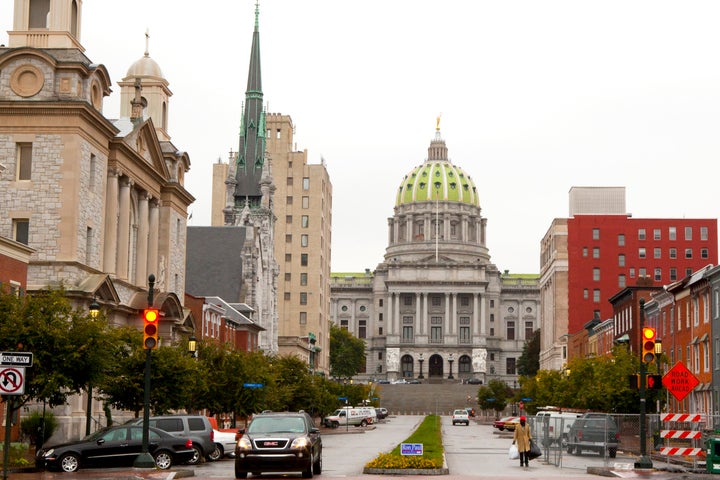
HARRISBURG, Pa. ― A plurality of state Supreme Court justices on Wednesday appeared open to the possibility that the Pennsylvania congressional map may violate the state’s constitution, but during oral argument seemed unclear as to how to remedy the situation.
The state’s map, which has been in place since 2012, gives Republicans a considerable advantage. The GOP consistently has been able to win 13 of the state’s 18 congressional seats despite winning just 50 percent of the vote. The Brennan Center for Justice describes the congressional map as one of the worst gerrymanders in the country, and analyses have found it to be responsible for at least three additional GOP seats in Congress.
During an oral argument that lasted about two and a half hours in a packed courtroom, the justices seemed resistant to the plaintiffs’ suggestion that any level of partisanship would be unacceptable in drawing district lines. Reaching such a conclusion would mean the court would be wading into redistricting more than any court had before, said Justice Debra McCloskey Todd.
But a plurality of the justices seemed more open to a map that took into consideration some partisan concerns as long as they were not given more importance than traditional, neutral redistricting requirements, such as those mandating districts be compact and contiguous. David Gersch, the lawyer for those challenging the congressional map, said such an approach would be acceptable as a fallback position.
Gersch argued that the case was a “straightforward” example of viewpoint discrimination. Republican lawmakers tasked with redrawing the state’s congressional districts sorted voters based on how they had voted in previous elections. Doing so, he said, “threatens to undermine the essence” of representative democracy.
Lawyers for the Republican defendants did not dispute that voters had been sorted into districts based on their past votes, but said that did not amount to impermissible viewpoint discrimination. They argued that social science could not necessarily predict how voters would cast their ballot, and that political parties were not a protected group the way racial groups are.
The case was filed by the League of Women Voters on behalf of 18 Pennsylvania Democratic voters, one in each of the state’s congressional districts.
“Justice David Wecht interjected to ask if the convenience of Republican voters trumped constitutional rights.”
E. Mark Braden, a lawyer for House Speaker Michael Turzai (R), said it was inconceivable that the constitution would give the power to redraw districts to a legislature without anticipating it would take political considerations into effect. Brady warned the justices against wading into the “political thicket,” arguing the body would weaken its integrity as an independent judicial body by taking on the political process of redistricting.
Gersch and Daniel Jacobson, another lawyer for the plaintiffs, said they were surprised at Brady’s admission that Republicans used Pennsylvanians’ past votes to sort them into districts. Brady argued it was unsurprising politicians would take politics into account when shaping drawing the new maps.
“They offered no substantive argument that this wasn’t intentional discrimination,” Jacobson told HuffPost.
Democrats have a 5-2 majority on the Pennsylvania Supreme Court, onto which justices are elected. The court has the final say in this case because it involves a challenge under the free expression and equal protection clauses of the state constitution.
A ruling would be deeply significant, both because it could force lawmakers to draw new, more competitive congressional districts ahead of the 2018 elections, and because it could encourage people in other states to bring similar claims.
The lawyers for the Republicans faced sharp questioning from Justice David Wecht, who seemed strongly leaning toward throwing out the map. He suggested the Republican defense in the case hinted that they believed there was no permissible limit on how far a partisan gerrymander could go. Wecht at one point comparing the defense of the map to the defense in Brown v. Board of Education, the landmark U.S. Supreme Court that said school segregation was unconstitutional.
Justice Max Baer also seemed leaning toward striking down the map, but appeared to wrestle with what a fix would look like. He repeatedly asked lawyers for both sides to give the court some kind of test to evaluate partisan gerrymanders. He wondered aloud if it would be constitutional to draw a district that was only Philadelphia and Pittsburgh, cities on opposite sides of the state, that were joined only by a single highway. A lawyer for the plaintiffs responded that courts had upheld a similarly drawn districts in Illinois.
Constitutional issues aside, the justices also wrestled with the practical impact of throwing out the state’s congressional map weeks before the start of the election process for the 2018 midterm elections. Noting that technology had made it possible for computers to draw hundreds of maps in one day, Gersch said it would be possible to draw the maps in two weeks.
Mark Aronchick, a lawyer representing Gov. Thomas Wolf (D) and state election officials, argued in favor of throwing out the map and said it would be possible to run the 2018 congressional election smoothly if the court decided to do so.
With a few adjustments, he said, the state could hold its scheduled primary congressional elections on May 15 if a new map was in place by Feb. 20. If a map came later, he said the state could either postpone all of the primary elections scheduled for May 15 or delay just the congressional primary date. Aronchick suggested the court give the legislature two or three weeks to redraw the map, but also appoint an expert special master who could work on maps at the same time in case the legislature did not move quickly enough.
Todd expressed concern about the cost of an additional primary. Lawrence Tabas, a lawyer for Republican voters supporting the map, said it would amount to substantial changes on the eve on an election and would infringe on the constitutional rights of voters in the state. He suggested leaving in place the current map for the 2018 election, even if the court struck it down, and ordering a new one for 2020.
Wecht interjected to ask him if the convenience of Republican voters trumped constitutional rights.
The case is being closely watched as courts across the country grapple with whether they can set a standard to determine when lawmakers go too far to draw electoral boundaries for their party’s benefit. The U.S. Supreme Court is considering two cases out of Maryland and Wisconsin this term that could help clarify that question. Observers are closely watching Justice Anthony Kennedy, who is seen as the deciding swing vote in the case and wrote in 2004 that such a standard may exist.
But regardless of what the Supreme Court does, experts say a ruling striking down the map could encourage groups to pursue lawsuits in state courts to challenge partisan gerrymandering. Conversely, a ruling upholding the map would increase the importance of the Supreme Court’s decision.
The lower commonwealth court initially put the Pennsylvania lawsuit on hold while the U.S. Supreme Court’s decisions were pending. The plaintiffs appealed to the Pennsylvania Supreme Court, which agreed to hear the case on an emergency expedited basis. At the Pennsylvania Supreme Court’s direction, Commonwealth Court Judge P. Kevin Brobson presided over a trial in December. In his recommendation to the Pennsylvania Supreme Court, which is nonbinding, Brobson noted partisan considerations were evident in the 2011 map and said it was possible to draw a fairer map using only neutral criteria. However, he also said the challengers had failed to offer a standard to evaluate partisan gerrymandering and failed to prove it violated the state’s constitution.
Drew Crompton, a lawyer for Senate President Pro Tempore Joseph Scarnati (R), hinted that Republicans were considering how to appeal to the U.S. Supreme Court should the Pennsylvania high court rule against them. He added that the League of Women Voters was using the lawsuit as a means to get more Democrats in Congress.
“If they create new law and new policy, then we’re just going to see what they do and what the remedy is and then decide whether or not we go to the U.S. Supreme Court,” Crompton told reporters. “Regardless of the plaintiffs trying to say that this is all state Supreme Court law and state constitutional, in the world that we live in, the federal law and the state law are intertwined. There’s no getting around that. And we should highlight the fact that these are congressional issues, so federal issues. I think we have a right to an appeal to the U.S. Supreme Court, I hope it doesn’t come to that.”
R. Stanton Jones, a lawyer for the plaintiffs, said such an appeal to the U.S. Supreme Court was “absolutely not available,” because the congressional map was only being challenged under the state constitution.
The gallery was mostly quiet during the hearing, but there were some moments of levity. How can it be so bad, Tabas wanted to know, if five Democrats are running for Congress in a district where Democrats allege a particularly egregious gerrymander for Republicans?
“Hope springs eternal,” Todd responded, prompting the courtroom to break out into laughter.
CORRECTION: A previous version of this story incorrectly described the reason the plaintiffs lawyers believe the case is not subject to U.S. Supreme Court review and misspelled the last name of David Gersch.
